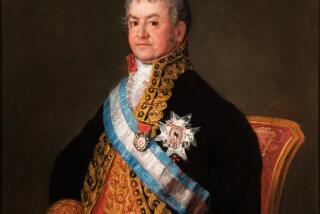Marine Artist Paints ‘Documents in History’
- Share via
John Stobart drove up from San Diego, where he is wintering, to make final arrangements for his part in the exhibition of paintings, prints and bronzes at the Balboa Bay Club today of prominent marine artists.
“I guess I’ll just stand beside my work and talk to people. No speeches, or anything like that,” he told me in his north-of-England accent over a pot of strong tea. Milk with sugar, thank you.
He talked of one of his more recent paintings--the brig Pilgrim, on which Richard Henry Dana sailed, lying off Point Loma. Like all of his richly detailed historical marine paintings, it was done in oil colors. He refuses to paint in any other media, particularly not acrylics; “after all, they’re very plastic and look it, and besides, acrylics dry too fast.”
Like almost all of his paintings, the Pilgrim oil has been reproduced as a full-color print in an edition of less than 950. Most of his print editions number 750. Any edition of 1,000 or more cannot be called a limited edition, he said. He believes that an edition is “unlimited” when it numbers more than 1,000.
Stobart got into the print business, forming a Boston company called Maritime History Prints, when he realized that his original oil paintings practically vanished into obscurity after they were sold.
“I didn’t go into this print business because of the money. I did a painting like that of the Cincinnati waterfront that took eight weeks, and sold for $120,000, and the damned thing would go into somebody’s private collection, and nobody would ever see it again. It was a document in history that had never been done before,” he said.
Stobart began his art career in Derbyshire when his father sent him to a provincial college of arts and crafts. “It was a wonderful place for kids, like I was, who couldn’t add 2 and 2 together. I was always drawing something.” He took to art like a ship to water. Eventually, he graduated from the Royal Academy of Art in London. He found his ultimate success in America 19 years ago by re-creating maritime scenes of American ships and ports in the 19th Century.
He voiced a complaint about art schools. “When you leave a college of art, what are you going to do with it? They push you out on the sidewalk and expect you to function. When you leave that college, you’ve got to sell your stuff, but nobody teaches you how to do that. I’d like to lecture at colleges on the business of art. Art is a downward path to nothing unless you’ve got a bit of business acumen.”
Stobart does most of his work in his studio in Boston, overlooking the harbor. But this time of year, he said, “Boston is unfit for human habitation.”
His paintings studiously render a wealth of accurate detail about ships and their environment. He carefully researches every project before starting to paint. Yet, he admits to chafing beneath the constraints of detail. “The detail is there because I’ve been caught in the vortex of public demand for it.” He’d like to paint more loosely, broadly.
“Perhaps someday I’m going up the river a little more and paint landscapes.”
Two other artists will join Stobart at today’s exhibit at the Balboa Bay Club from noon to 4 p.m. They are Keith Reynolds, noted for his maritime serigraphs, and Randy Puckett, who sculptures marine mammals. Reynolds will unveil a poster he made under commission by the New York Yacht Club for its America’s Cup challenge. The exhibit is sponsored by the Whitman Galleries of Corona del Mar.
And if anybody there should offer Stobart a cup of tea, please remember that he likes it to be of a good strong color, with milk and plenty of sugar in it.
More to Read
The biggest entertainment stories
Get our big stories about Hollywood, film, television, music, arts, culture and more right in your inbox as soon as they publish.
You may occasionally receive promotional content from the Los Angeles Times.










